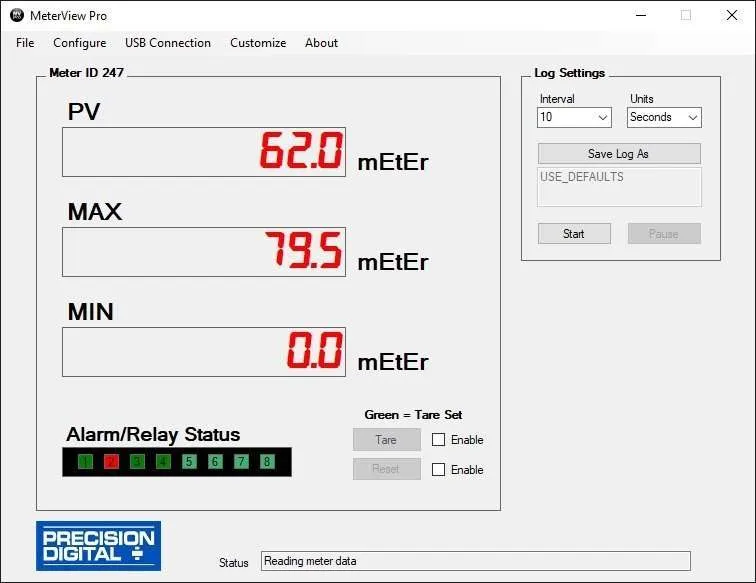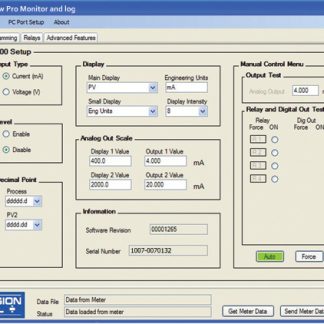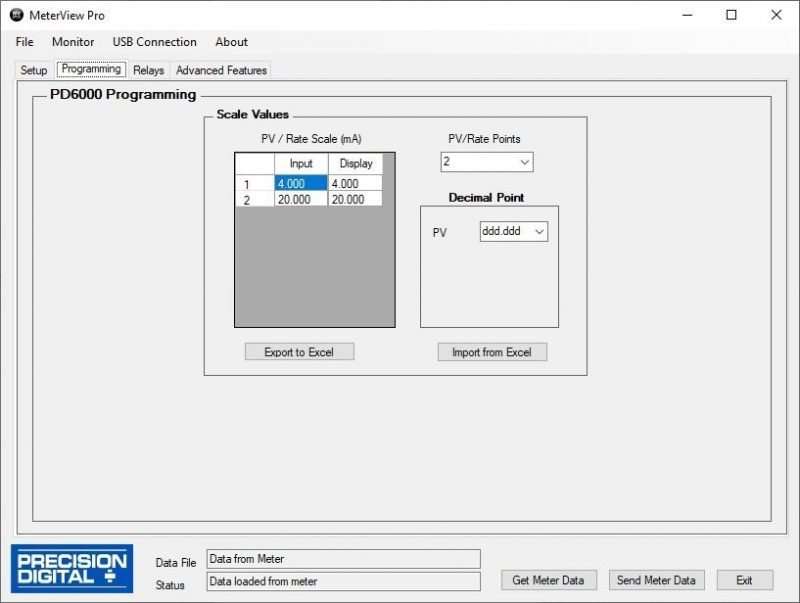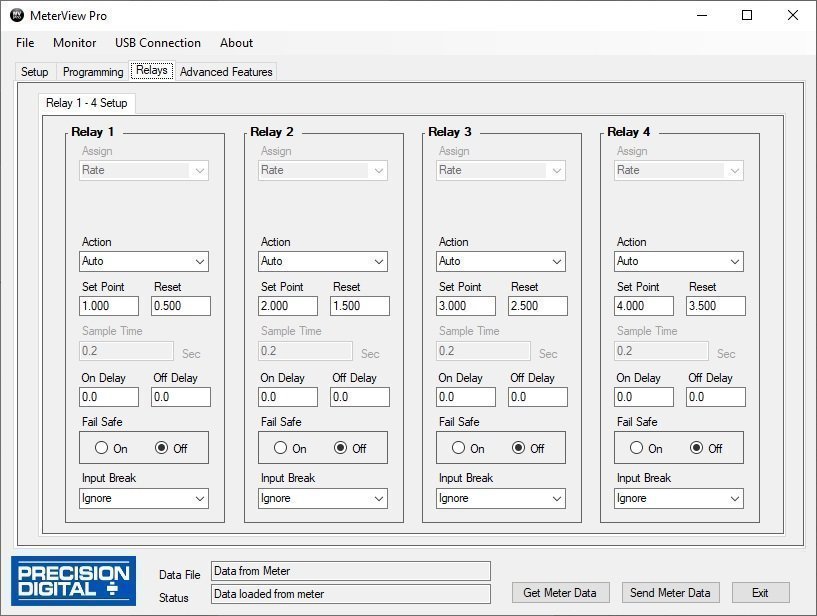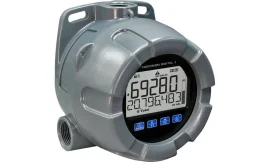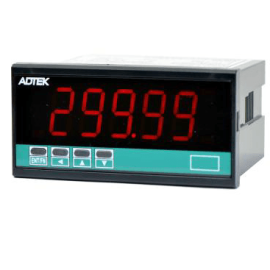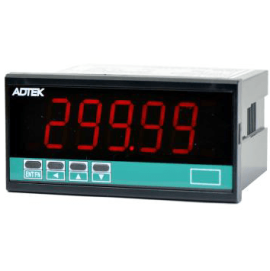Input
High Voltage: (Channel V) 0-300 VDC or VAC;
High Current: (Channel A) 0-5 AAC or ADC;
Both Switch Selectable.
Helios Features
- Large 1.80″ Digits
- Dual Line Display
- Six Full Digits on Each Line
- Readable From 100 Feet Away
- Superluminous Sunlight Readable Display
- NEMA 4X, IP65 Rated Field Mountable Enclosure
- Great for Outdoor Use: -40 to 150°F (-40 to 65°C)
- Program the Meter from a PC with Onboard USB and MeterView® Pro
PD2-6400 Features
- Displays Voltage and Current Simultaneously
- Multiplication for Apparent Power Calculation
- Up to Three 4-20 mA Analog Outputs Available
Introducing the Helios PD2-6400, a standout in the world of large display meters. What makes the Helios unique is its dual line display featuring super bright LEDs. You can easily read it even in bright sunlight and from distances of up to 100 feet.
Built on Precision Digital’s renowned ProVu® digital panel meters, the Helios is versatile and can handle a wide range of applications, including:
- Level measurement
- Flow monitoring
- Temperature tracking
- Pressure readings
- Weight measurement
This meter supports various input types, making it suitable for many uses:
- 4-20 mA signals
- Thermocouples
- RTDs
- Pulses
- Strain gauges
- AC and DC voltage and current
- Modbus® communication
Choose the Helios PD2-6400 when you need a reliable display for voltage and current. Its large display ensures visibility from afar, and it can even calculate and show apparent power by multiplying the two inputs. Experience clarity and precision with the Helios today!
Except where noted all specifications apply to operation at +25°C.
General
Display: Two lines with 1.8″ (46 mm) high digits, red LEDs; 6 digits per line (-99999 to 999999), with lead zero blanking
Display Intensity Eight user selectable intensity levels
Display Update Rate: 5/second (200 ms)
Overrange: Display flashes 999999
Underrange: Display flashes -99999
Display Assignment: Displays lines 1 & 2 may be assigned to process values for Channels A (Ch-A, current), V (Ch-V, voltage), or P (Ch-P, apparent power); toggle between (Ch-A & Ch-V, Ch-A & Ch-P, Ch-V & Ch-P, and Ch-A, Ch-V, & Ch-P); relay set points; max and/or min values for CH-A, Ch-V, or Ch-P; CH-A and units; Ch-V and units; Ch-P and units; or Modbus input. The lower display may also be set to show engineering units or be off, with no display.
Programming Methods: Four programming buttons, digital inputs, PC and MeterView Pro software, or Modbus registers.
Noise Filter: Programmable from 2 to 199 (0 will disable filter)
Filter Bypass: Programmable from 0.1 to 99.9% of calibrated span
Recalibration: All ranges are calibrated at the factory. Recalibration is recommended at least every 12 months.
Max/Min Display: Max/min readings reached by the process are stored until reset by the user or until power to the meter is turned off.
Password: Three programmable passwords restrict modification of programmed settings.
Pass 1: Allows use of function keys and digital inputs
Pass 2: Allows use of function keys, digital inputs and editing set/reset points
Pass 3: Restricts all programming, function keys, and digital inputs.
Power Options: 85-265 VAC 50/60 Hz, 90-265 VDC, 20 W max or 12-24 VDC ± 10%, 15 W max. Powered over USB for configuration only.
Non-Volatile Memory: All programmed settings are stored in non-volatile memory for a minimum of ten years if power is lost.
Fuse: Required external fuse: UL Recognized, 5 A max, slow blow; up to 6 meters may share one 5 A fuse
Isolation: 500 V AC/DC potential allowed between voltage and current input channels. Channels isolated by 3 MΩ impedance. 4 kV input/output-to-power line. 500 V input-to-output or output-to-P+ supply.
Overvoltage Category: Installation Overvoltage Category II: Local level with smaller transient overvoltages than Installation Overvoltage Category III.
Environmental: Operating temperature range: -40 to 150°F (-40 to 65°C); Storage temperature range: -40 to 185°F (-40 to 85°C); Relative humidity: 0 to 90% non-condensing
Connections: Removable and integrated screw terminal blocks accept 12 to 22 AWG wire.
Enclosure: UL Type 4X, IP65 rated. Polycarbonate & glass blended plastic case, color: gray. Includes four PG11 through-hole conduit openings, with two factory installed PG11, IP68, black nylon threaded hole plugs with backing nuts.
Wall Mounting: Four (4) mounting holes provided for mounting meter to wall.
Pipe Mounting: Optional pipe mounting kit (PDA6260) allows for pipe mounting. Sold separately.
See PD2-6400 manual for instructions.
Tightening Torque: Removable Screw Terminals: 5 lb-in (0.56 Nm)
Digital I/O and RS485 Terminals: 2.2 lb-in (0.25 Nm)
Overall Dimensions: 10.63″ x 12.59″ x 4.77″ (270 mm x 319.7 mm x 121.2 mm) (H x W x D)
Weight: 6.10 lbs (2.76 kg)
UL File Number: UL & C-UL Listed. E160849; 508 Industrial Control Equipment.
Warranty: 3 years parts & labor
USB Connection: Compatibility: USB 2.0 Standard, Compliant
Connector Type: Micro-B receptacle
Cable: USB A Male to Micro-B Cable
Driver: Windows 98/SE, ME, 2000, Server 2003/2008, XP 32/64-Bit, Vista 32/64-Bit, Windows 7 32/64-Bit, Windows 10 32/64-Bit
Power: USB Port
Voltage and Current Inputs
High Voltage Input: One high voltage input (Channel V), 0-300 VDC or VAC; Switch Selectable, Modbus PV (Slave)
High Current Input: One high current input (Channel A), 0-5 AAC or ADC; Switch Selectable, Modbus PV (Slave)
Channels: Channel A, Channel V, Channel P (Math Channel for Apparent Power)
AC/DC Selection:Switch selectable for AC or DC inputs. Channels A and V share AC/DC selection.
Apparent Power Math:Apparent power P calculated as P = ((A * V) + C) * F
Programmable Constants:Constant C (Adder): -99.999 to 999.999, default: 0.000, Constant F (Factor): 0.001 to 999.999, default: 1.000
Accuracy: ADC: 0.03% Full Scale ±1 count, AAC: 0.1% Full Scale ±1 count, VDC: 0.05% Full Scale ±1 count, VAC: 0.15% Full Scale ±1 count, square root & programmable exponent accuracy, range: 10-100% of calibrated span
Temperature Drift: 0.005% of calibrated span/°C max from -40 to 65°C ambient
Signal Input Conditioning: Linear, square root, programmable exponent, or round horizontal tank volume calculation
Multi-Point Linearization: 2 to 32 points for Channel A and V
Low-Flow Cutoff:0-999999 (0 disables cutoff function). Independent for Channel A and V.
Decimal Point: Up to five decimal places or none: d.ddddd, d.dddd, d.ddd, d.dd, d.d, or dddddd
Calibration Range:
| Input Channel | Input Range | Minimum Span Input 1 & Input 2 |
| A | +/- 0-5 ADC 0-5 AAC | +/- 0.005 ADC 0.010 AAC |
| V | +/- 0-300 VDC 0-300 VAC | +/- 0.1 VDC 0.3 VAC |
An Error message will appear if the input 1 and input 2 signals are too close together.
Input Impedance:Voltage Input: Greater than 3 MΩ, Current Input: 50 – 100 Ω
Input Overload: Voltage input protected up to 500 VDC. Current input protected up to 10 A by a 10A/300V fast acting non-resettable fuse. Fuse is NOT resettable after a fault; unit must be factory reconditioned.
F4 Digital Input Contacts: 3.3 VDC on contact. Connect normally open contacts across F4 to COM.
F4 Digital Input Logic Levels: Logic High: 3 to 5 VDC, Logic Low: 0 to 1.25 VDC
Relays
Rating: 2 or 4 SPDT (Form C) internal and/or 4 SPST (Form A) external; rated 3 A @ 30 VDC and 125/250 VAC resistive load; 1/14 HP (≈ 50 W) @ 125/250 VAC for inductive loads
Noise Suppression: Noise suppression is recommended for each relay contact switching inductive loads. See manual for details.
Deadband: 0-100% of span, user programmable
High Or Low Alarm: User may program any alarm for high or low trip point. Unused alarm LEDs and relays may be disabled (turn off).
Relay Operation: Automatic (non-latching) and/or manual reset; Latching (requires manual acknowledge) with/without clear; Pump alternation control (2 to 4 relays); Sampling (based on time); Off (disable unused relays and enable Interlock feature); Manual on/off control mode
Relay Reset: User selectable via front panel buttons or digital inputs
- Automatic reset only (non-latching), when the input passes the reset point.
- Automatic + manual reset at any time (non-latching)
- Manual reset only, at any time (latching)
- Manual reset only after alarm condition has cleared (latching)
Note: Front panel button or digital input may be assigned to acknowledge relays programmed for manual reset.
Time Delay: 0 to 999.9 seconds, on & off relay time delays; Programmable and independent for each relay
Fail-Safe Operation: Programmable and independent for each relay. Note: Relay coil is energized in non-alarm condition. In case of power failure, relay will go to alarm state.
Auto Initialization: When power is applied to the meter, relays will reflect the state of the input to the meter.
Isolated 4-20 mA Transmitter Output
Output Source: Process variable (PV), max, min, set points 1-4, Modbus input, or manual control mode
Scaling Range: 1.000 to 23.000 mA for any display range
Calibration: Factory calibrated: 4.000 to 20.000 = 4-20 mA output
Analog Out Programming: 23.000 mA maximum for all parameters: Overrange, underrange, max, min, and break
Accuracy: ± 0.1% of span ± 0.004 mA
Temperature Drift: 0.4 µA/°C max from 0 to 65°C ambient, 0.8 µA/°C max from -40 to 0°C ambient
Note: Analog output drift is separate from input drift.
Isolated Transmitter Power Supply: Terminals I+ & R: 24 VDC ± 10%. Isolated from the input at >500 V. May be used to power the 4-20 mA output or other devices. All skus rated @ 40 mA max.
External Loop Power Supply: 35 VDC maximum
Output Loop Resistance:
| Power supply | Minimum | Maximum |
| 24 VDC | 10 Ω | 700 Ω |
| 35 VDC (external) | 100 Ω | 1200 Ω |
RS485 Serial Communications Terminal
Compatibility: EIA-485
Connectors: Removable screw terminal connector
Max Distance: 3,937′ (1,200 m) max
Status Indication: Separate LEDs for Power (P), Transmit (TX), and Receive (RX)
Modbus® RTU Serial Communications Protocol
Slave: ID 1 – 247 (Meter address)
Baud Rate: 300 – 19,200 bps
Transmit Time Delay: Programmable between 0 and 199 ms
Data: 8 bit (1 start bit, 1 or 2 stop bits)
Parity: Even, Odd, or None with 1 or 2 stop bits
Byte-To-Byte Timeout: 0.01 – 2.54 second
Turn Around Delay: Less than 2 ms (fixed)
Note: Refer to the Modbus Register Tables located at www.predig.com for details.
Digital Input & Output Terminal
Channels: 4 digital inputs & 4 digital outputs
Digital Input Logic High: 3 to 5 VDC
Digital Input Logic Low: 0 to 1.25 VDC
Digital Output Logic High: 3.1 to 3.3 VDC
Digital Output Logic Low: 0 to 0.4 VDC
Source Current: 10 mA maximum output current
Sink Current: 1.5 mA minimum input current
+5 V Terminal: To be used as pull-up for digital inputs only. Connect normally open pushbuttons across +5 V & DI 1-4.
WARNING! DO NOT use +5 V terminal to power external devices.
Dimensions
Wall Mounting
The meter can be mounted to any wall using the four provided mounting holes. Note that the bottom mounting holes are located underneath the front door panel. To mount the meter to a wall, follow these instructions.
- Prepare a section of the wall approximately 11″ x 13″ (280 mm x 330 mm) for meter mounting by marking with a pencil the mounting holes (shown in the image to the right) on the wall.
- Using a drill bit slightly smaller than the girth of the mounting screws, pre-drill holes at the mounting locations previously marked.
- Insert mounting screws into the four mounting holes and screw them into the pre-drilled holes. Do not overtighten the mounting screws as it is possible that the enclosure could crack and become damaged.
Meter Mounting Holes
Pipe Mounting
The meter can also be mounted to a pipe using the optional pipe mounting kit (PDA6260). This kit includes two mounting plates, two U-bolts, and the necessary nuts and bolts. To mount the meter to a pipe using the pipe mounting kit accessory, follow these instructions.
- Secure the mounting plates to the top and bottom (for vertical pipes) or left and right (for horizontal pipes) of the reverse side of the meter enclosure using the provided fasteners. Do not overtighten the fasteners as it could cause damage to the enclosure.
- Using the provided nuts and U-bolts, secure the mounting plates to the pipe enough torque such that the meter cannot be moved up or down (or side to side).

Horizontal Pipe Mount Assembly

Vertical Pipe Mount Assembly
Connections Labeling
The connectors’ label, affixed to the inside of the lower door panel, shows the location of all connectors available with requested configuration.

Applications
The Helios PD2-6400 can be used to display application data for voltage, current, or both. Each Channel, Voltage or Current, can be scaled independently. The following examples show just a few of the PD2-6400’s application capabilities using generators and transformers. Each example is accompanied by a wiring diagram that shows the proper switch position for the meter. Voltage Measurement for a Generator Driving a LoadVoltage & Current Measurement for a Transformer Driving a LoadCurrent Measurement for a Lighting System |
MeterView® Pro Software
 MeterView® Pro software is designed for use with ProVu, ProtEX-MAX, or Helios Series meters and allows users to remotely program, monitor, and datalog using a PC. Remote programming allows for all available meter settings to be programmed through an easy, user-friendly interface. The data acquisition feature allows the user to gather readings from a meter at user-selected intervals and generate charts using common tools like Microsoft® Excel. A linearization setup function is also included. With this utility the user can configure up to 32 linearization points and upload them to the meter. All configuration data can be saved to a file for future use.
MeterView® Pro software is designed for use with ProVu, ProtEX-MAX, or Helios Series meters and allows users to remotely program, monitor, and datalog using a PC. Remote programming allows for all available meter settings to be programmed through an easy, user-friendly interface. The data acquisition feature allows the user to gather readings from a meter at user-selected intervals and generate charts using common tools like Microsoft® Excel. A linearization setup function is also included. With this utility the user can configure up to 32 linearization points and upload them to the meter. All configuration data can be saved to a file for future use.
This software is accessible via the onboard USB connection on all Helios large display meters, ProVu panel meters, and ProVu-based ProtEX-MAX explosion-proof meters produced since 6 September 2016 (firmware version 4.0 or higher). In order for meters produced prior to 6 September 2016 (firmware version 3.1 or lower) to establish digital communications with a PC, a serial communications adapter is required. For an RS-232 connection, use a PDA1232adapter.
To determine the software version of a meter:
- Go to the Diagnostics menu (
 ) and press Enter button.
) and press Enter button. - Press Up arrow button and scroll to Information menu (Info
 ).
). - Press Enter to access the software number (
 ), version (
), version ( ), and serial number (
), and serial number ( ) information. Write down the information as it is displayed. Continue pressing Enter until all the information is displayed.
) information. Write down the information as it is displayed. Continue pressing Enter until all the information is displayed. - The meter returns to Run Mode after displaying all the settings.
Monitor and Datalog

Setup

Programming

Relays


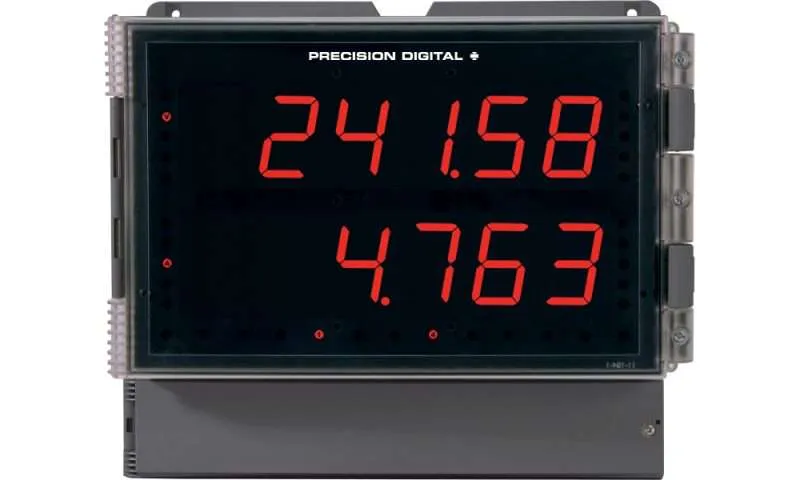
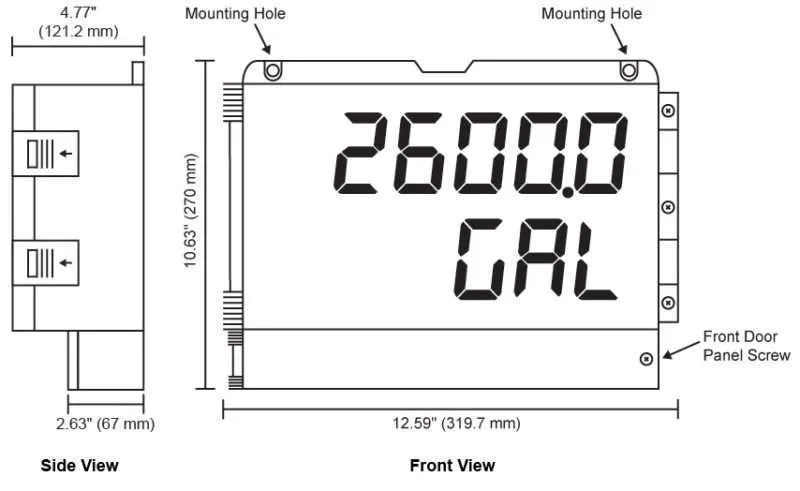
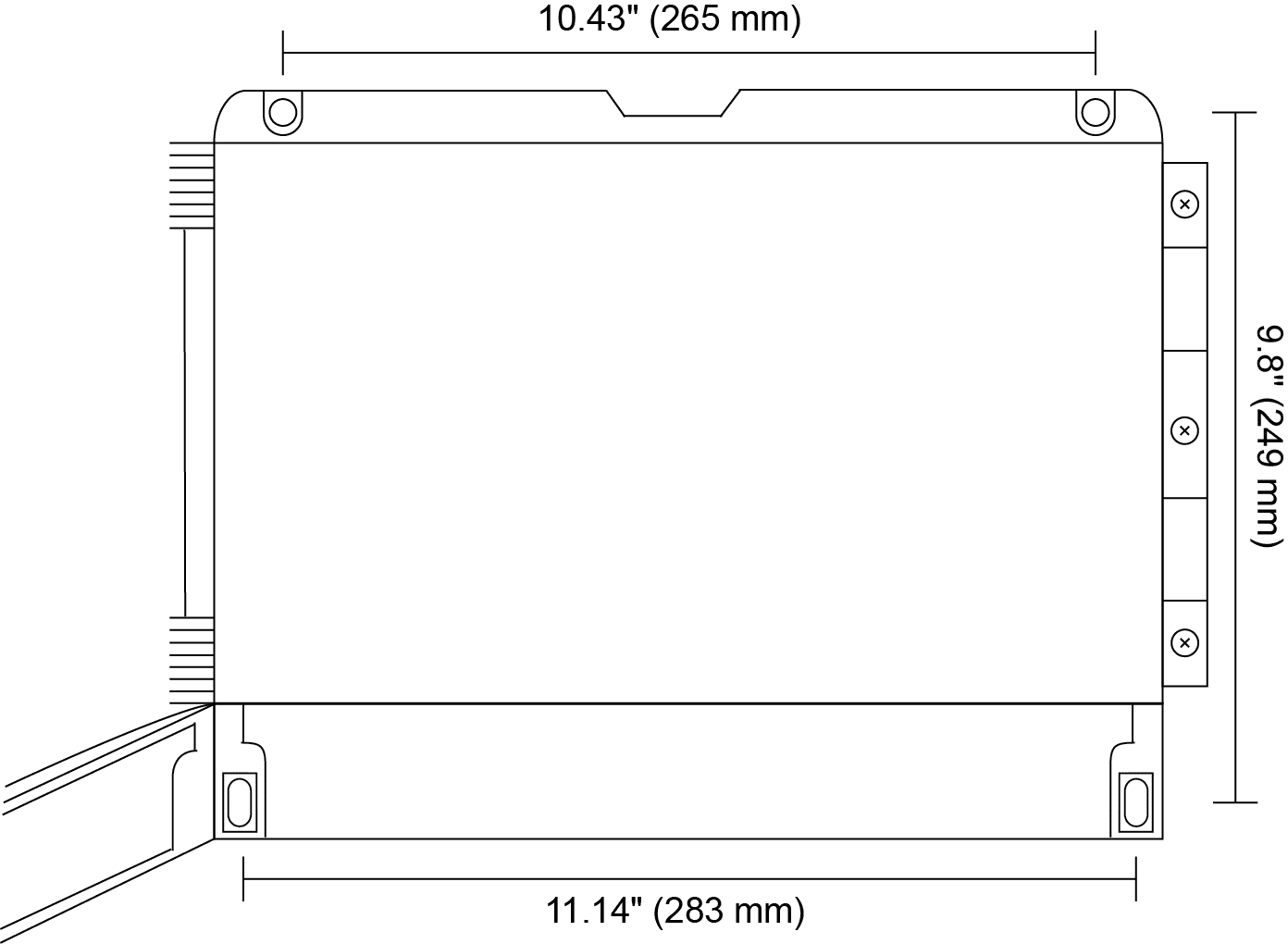
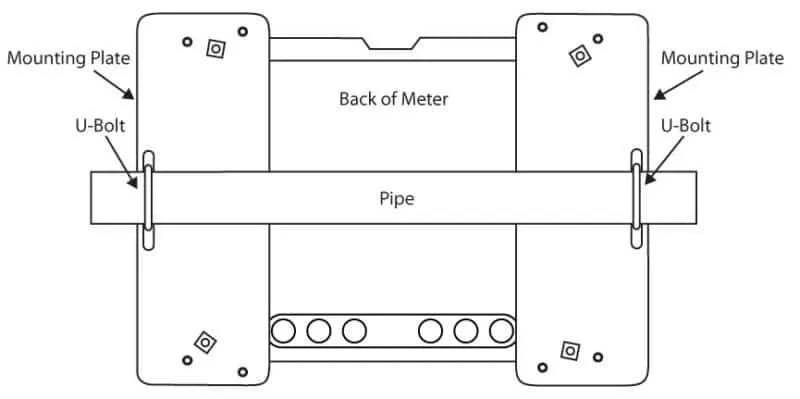
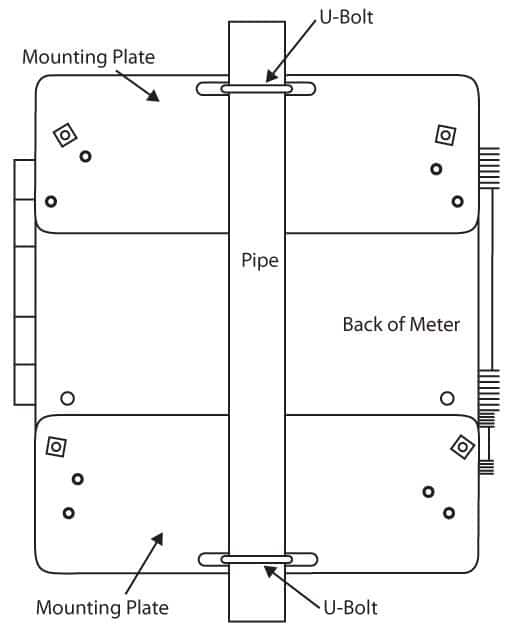

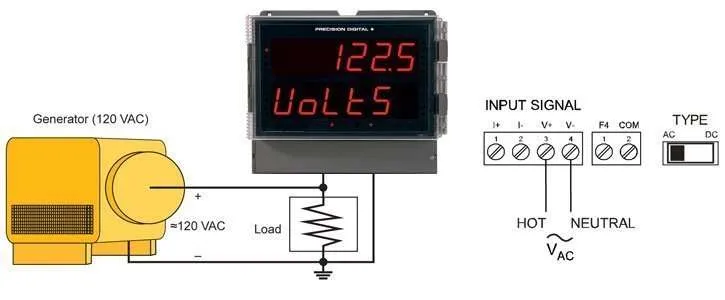
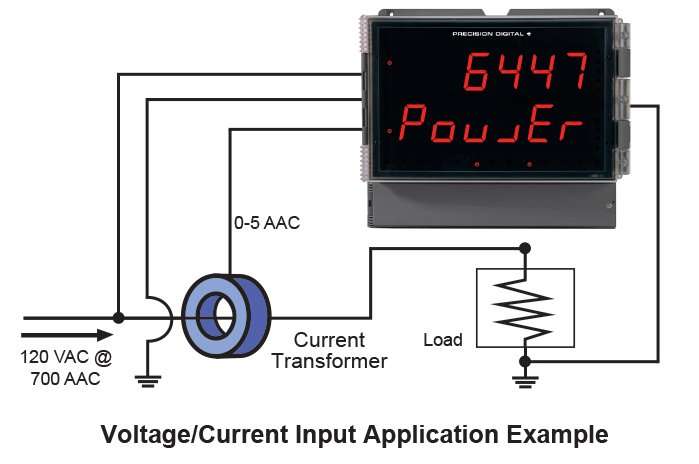
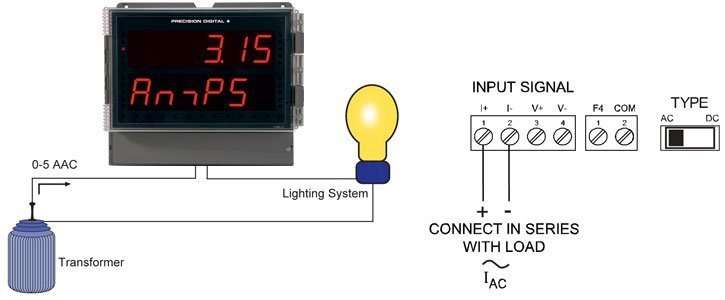
 MeterView® Pro software is designed for use with ProVu, ProtEX-MAX, or Helios Series meters and allows users to remotely program, monitor, and datalog using a PC. Remote programming allows for all available meter settings to be programmed through an easy, user-friendly interface. The data acquisition feature allows the user to gather readings from a meter at user-selected intervals and generate charts using common tools like Microsoft® Excel. A linearization setup function is also included. With this utility the user can configure up to 32 linearization points and upload them to the meter. All configuration data can be saved to a file for future use.
MeterView® Pro software is designed for use with ProVu, ProtEX-MAX, or Helios Series meters and allows users to remotely program, monitor, and datalog using a PC. Remote programming allows for all available meter settings to be programmed through an easy, user-friendly interface. The data acquisition feature allows the user to gather readings from a meter at user-selected intervals and generate charts using common tools like Microsoft® Excel. A linearization setup function is also included. With this utility the user can configure up to 32 linearization points and upload them to the meter. All configuration data can be saved to a file for future use.